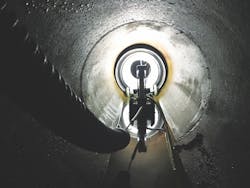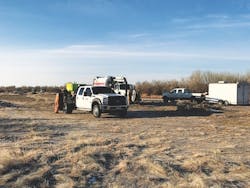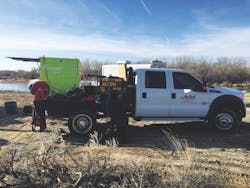Point Repair Project
Angus W. Stocking, L.S., is a licensed land surveyor who has been writing about infrastructure since 2001. Stocking can be reached at [email protected] or 970.527.4326.
undefinedWorland, a Wyoming city with a population of 8,000, recently used a point repair solution to rehabilitate 250 ft of 24-in. diameter clay pipe sewer.
“This was a small section of an 18,000-ft collection line, where a heavy winter with lots of snow had washed out cover,” said Brian Martinsen, owner and operator of project contractor Kleen Pipes. “For clay pipe installed in 1957, it was in remarkably good shape. But video inspection revealed six joints where infiltration was significant—three were gushers and three were dripping significantly just from groundwater, which is high in Wyoming.”
This line feeds a lift station pumping to lagoons, so the city was eager to reduce infiltration, as that would immediately reduce system costs. When pipe is in relatively good condition, with damaged areas confined to joints or short sections, point repair often is a suitable and cost-effective rehabilitation solution, and it is fast as well. Worland officials approached Martinsen, who had recently seen a demonstration of a new point repair technology called Quick-Lock, supplied by Pipeline Renewal Technologies.
After reviewing the solution themselves, Worland and Martinsen agreed that it could be used for their clay collector. This project was the first use of Quick-Lock in the city, and also a first for Kleen Pipes.
When looking to fix pipes near joints or in limited sections of the pipe, point repair is a fast option with immediate results.
Installing the Tech
Quick-Lock is a rigid, compressible cylinder made of heavy-gauge stainless steel inside a gasketed rubber sleeve. The whole assembly is inserted into pipes and sewers with an inspection crawler. An inflatable rubber bladder is then used to expand the ratcheted steel cylinder, locking the rubber sleeve tightly in place around the entire area of the leak.
“It’s a bit like a reverse zip tie,” Martinsen said. “Once it expands, it locks in place and doesn’t budge.” This instantly and permanently seals off damaged areas, and since the Quick-Lock assembly is low profile, sewer flow capacities are minimally affected. No epoxies or resins are used.
“I’ve previously used another solution that required epoxy,” Martinsen said. “It worked, but it was tricky to use—we had to get everything ready, put on the epoxy, then insert it and get it in place within 20 minutes. And if you didn’t get it in place within 20 minutes, you were in a pickle. Quick-Lock is much more convenient. The rubber sleeve just locks in and seals the pipe—it’s pretty slick.”
In Worland, Kleen Pipe spent about two weeks on site, but most of that time was spent jetting and cleaning the pipe, and using video to precisely locate the six damaged areas.
“We also learned that the clay pipe really was in good shape,” Martinsen said. “There was very little movement in the pipe, and no big offsets at the joints. That made it ideal for inserting a point repair solution, because we could insert larger-diameter packages into manholes and all the way to the leaks.”
All six point repair assemblies were inserted in a single day in Worland, Wyo., using a camera and laser pointer mounted on the packer. A second camera ahead of the packer helped guide the pieces into place.
Six Leaks, One Day
All six assemblies were inserted in one day using a packer rented from the distributor. A camera and laser pointer mounted on the packer was used to precisely locate leaks and position the sleeves. A second camera unit was inserted ahead of the packer and was used to pull the pieces into place.
“There was mastic at some of the joints, creating some resistance,” Martinsen said. “It was very helpful to have a way to pull as well as push.”
In Worland, Kleen Pipe used 16-in. units, compressed to about a 20-in. diameter. This was long enough to securely cover leaking joints and compact enough to maneuver through manholes and pipe. Once in place, a rubber bladder was inflated to expand the stainless steel sleeve and lock in the cameras. The expanding bladder was alternately applied at each end of the sleeve for a total of three cycles to ensure even and tight expansion.
Video inspection confirmed that leaks were sealed, and the solution should remain stable for decades. Worland plans to inspect the area annually, but for now it is very happy with the results.
“I’m glad this solution is available,” Martinsen said. “We could have used another point repair method, but it wouldn’t have been as fast or good, and lining this section would have been overkill.” He intends to keep using Quick-Lock as one of his preferred solutions, and has already seen interest from two additional Wyoming towns.


